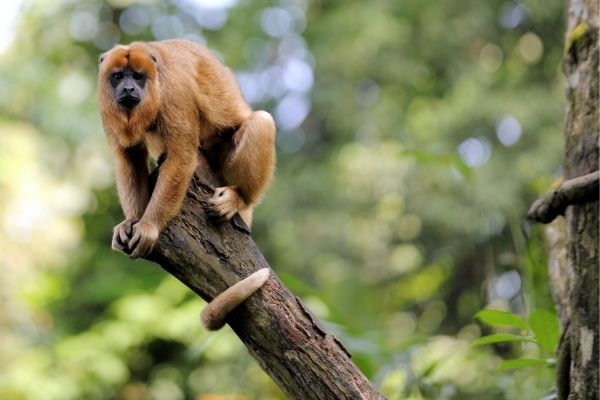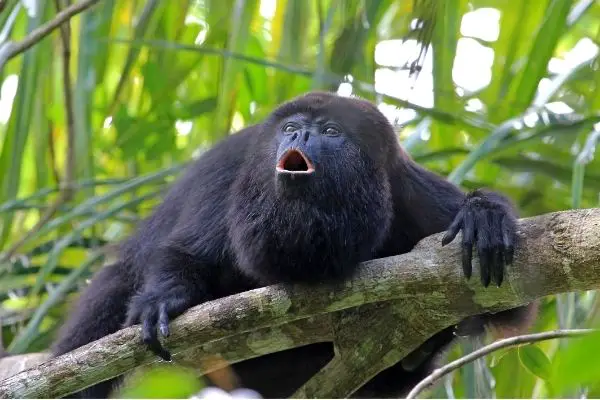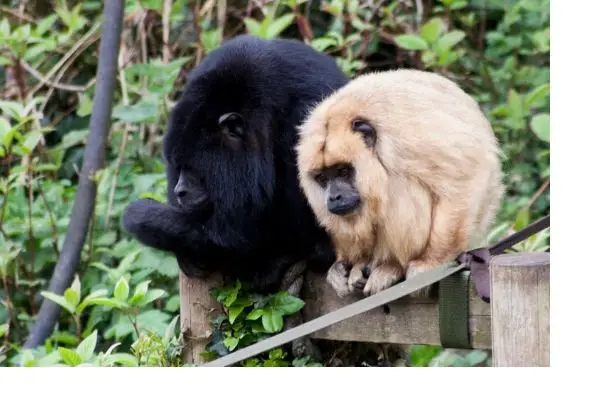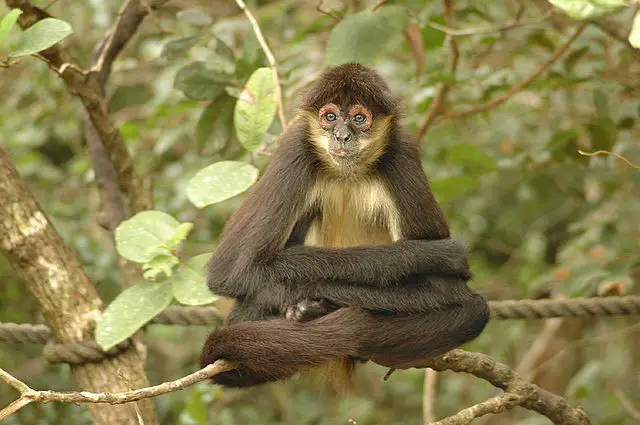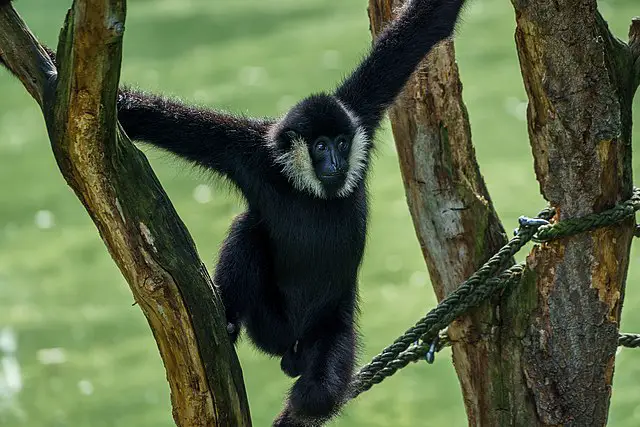Howler Monkeys are known for their loud howl (sound), which can be heard at a distance of up to 5 km. We can say that they are the loudest monkeys in the world. We have listed down complete Howler Monkeys Facts for Kids that will help you in learning all about Howler Monkeys. You are going to learn about its scientific name & classification, evolution, appearance, physical features, physical abilities, diet, habitat, lifespan, reproduction, babies, behavior, adaptations, food chain, ecological role, endangerment, population, predators, and many other interesting facts about Howler Monkeys.
Howler Monkeys Facts For Kids
What Is A Howler Monkey
- Howler monkeys are among the biggest New World monkeys.
- They are indigenous to the forests of South and Central America.
- They are well-known for their loud howls and are the loudest terrestrial animals in the Western Hemisphere.
- They belong to the family Atelidae.
- There are 15 recognized species of howler monkeys.
- Three species are listed as Endangered and five as Vulnerable on the IUCN Red List.
- Major threats to their survival are habitat destruction and human predation.
Scientific Name Of Howler Monkey
- The scientific name of the howler monkey is Alouatta.
Scientific Classification Of Howler Monkey
- The following is the scientific classification or taxonomy of howler monkey:
| Kingdom | Animalia |
| Phylum | Chordata |
| Subphylum | Vertebrata |
| Class | Mammalia |
| Order | Primates |
| Suborder | Haplorhini |
| Infraorder | Simiiformes |
| Family | Atelidae |
| Subfamily | Alouattinae |
| Genus | Alouatta |
Howler Monkey Species
- There are 15 recognized species of the howler monkeys. The following is a brief description of all the species:
- Ursine howler (Alouatta arctoidea)
It is indigenous to Venezuela. Sometimes, it is considered as a subspecies of Venezuelan red howler. - Red-handed howler (Alouatta belzebul)
It is indigenous to Brazil, where it is found in the southeastern Amazon and Atlantic forests. - Black howler (Alouatta caraya)
Black howler is the southernmost species of the genus Alouatta along with brown howler. It is found in southern and eastern Brazil, eastern Bolivia, northeastern Argentina, and Paraguay. - Coiba Island howler (Alouatta coibensis)
This species is indigenous to Panama. - Spix’s red-handed howler (Alouatta discolor)
This species is indigenous to Brazil, where it is found in the southeastern Amazon. The biggest threats to the survival of this species are deforestation and excessive hunting. - Brown howler (Alouatta guariba)
This species is found in southeastern Brazil and northeastern Argentina. The coat color of this species may be brown, reddish-orange, and black. This species is further divided into two subspecies:- northern brown howler (Alouatta guariba guariba)
- southern brown howler (Alouatta guariba clamitans).
- Juruá red howler (Alouatta juara)
This species is found only in Brazil and Peru. - Guyanan red howler (Alouatta macconnelli)
This species is indigenous to Brazil, Venezuela, French Guiana, Suriname, Guyana, and Trinidad. - Amazon black howler (Alouatta nigerrima)
This species is found only in the south-central Amazon, in Brazil. - Mantled howler or golden-mantled howling monkey (Alouatta palliata)
This species has long guard hairs on the sides that is why it is named mantled. It is indigenous to Columbia, Costa Rica, Ecuador, Guatemala, Honduras, Mexico, Nicaragua, Panama, and Peru. - Guatemalan black howler or Yucatan black howler (Alouatta pigra)
This species is found in the Yucatan Peninsula, Mexico, Guatemala, and Belize. This species is listed as Endangered by the IUCN Red List. - Purús red howler (Alouatta puruensis)
This species is indigenous to Brazil, Peru, and northern Bolivia. - Bolivian red howler (Alouatta sara)
This species is found only in the rainforests in Bolivia. - Colombian red howler or Venezuelan red howler (Alouatta seniculus)
This species is found in the western Amazon Basin (Brazil, Peru, Ecuador, Columbia, and Venezuela). - Maranhão red-handed howler (Alouatta ululata)
This species is found only in the northeastern Brazilian states of Maranhão, Ceara, and Piaui. This species is included in the list of Endangered species on the IUCN Red List.
Evolution Of Howler Monkey
- Two species of howler monkeys (black howler monkey and mantled howler monkey) are believed to have diverged more than 3 million years ago.
What Does A Howler Monkey Look Like
Appearance
- Howler monkeys have hunched appearance.
- They have stout built and their bodies are covered with long and thick fur.
- They are bearded monkeys.
- They have short snouts and roundish wide nostrils.
- They have high sloping faces with protruding jaws. They also have a large throat and enlarged hyoid.
- Their hands have five fingers. The first two fingers are opposable to the other three.
- They have 36 teeth. Their dental formula is (Incisors) 2/2, (Canines) 1/1, (Premolars) 3/3, (Molars) 3/3. Their sharp upper molar teeth have shearing crests, which they use for grinding leaves.
- They have long and prehensile tails covered with thick fur. The tip of the tail is nicked at the underside to provide a better grip.
- A major characteristic of howler monkeys is enlarged hyoid bone (a horseshoe-shaped bone located in the anterior midline of the neck) that expanded into a large shell-like organ in the throat. It gives an exceptional resonance to their voice.
Color
- The fur color of howler monkeys is usually black, brown, or red, depending on the species.
- Male and female individuals of one species, black howler monkeys, have different fur colors. It is one of the few primate species with such characteristics. Male black howler monkeys have black fur while females have blonde fur.
Physical Features
-
Height
-
- Howler monkeys have 22 to 36 inches in height.
-
Weight
-
- The bodyweight of howler monkeys ranges from 4 to 10kg (9 to 22 lbs).
- As howler monkeys have sexual dimorphism, so males usually have 1.5 to 2.0 kg larger bodyweight than females.
-
Length
-
- Howler monkeys are the largest of New World monkeys.
- Their body length ranges from 16 to 28 inches (40 to 70 cm).
- They have a 20 to 30 inches (50 to 75 cm) long tail.
Physical Abilities
-
Speed
-
- Howler monkeys are slow-moving and not agile and fast like most other monkeys.
- Their moving speed is unknown.
-
Climb
-
- Howler monkeys are excellent climbers.
- They inhabit trees and are well adapted to climb.
- They use their limbs and tail to climb a tree.
- To grasp tree branches, they use one or two hands and their prehensile tail.
-
Swim
-
- Some species of howler monkeys are observed swimming.
- However, their swimming speed is unknown.
What Do Howler Monkeys Eat
Diet
-
In Wild
-
- Howler monkeys are folivores in nature and mostly eat leaves of the trees as their primary diet.
- They are the only leaves-eating (folivores) monkeys of the New World monkeys.
- They mainly eat the leaves of the top canopy regions of the forest trees.
- They also eat buds, flowers, fruits, and nuts.
- Howler monkeys usually need to stay careful not to consume too many leaves of certain tree species in a single meal. As some trees could contain toxins that can poison them.
- They are also known to sometimes raid on the nests of birds and coops of the chickens and eat their eggs. They also sometimes eat insects. They need to do so because they are primates and need a proper amount of B12 vitamin for the normal functioning of their nerves.
- Howler monkeys fulfill all their water requirements from the leaves they eat.
-
In Captivity
-
- In captivity, howler monkeys are fed with primate biscuits, spinach, browse, lettuce, kale, sweet potatoes, broccoli, green beans, carrots, bananas, grapes, apples, melons, and other greens.

-
List Of Food Items
Howler monkeys mostly eat the following items:
-
- Leaves of trees
- Buds
- Fruits
- Nuts
-
What Do Baby Howler Monkey Eat
-
- Baby howler monkeys are fed on the mother milk for the initial days of their life.
- They then also start eating adult diets as they grow bigger.
Where Do Howler Monkeys Live – Howler Monkey Habitat
Natural Habitat
- The natural habitat of howler monkeys is a mountain and lower elevation forests.
- They inhabit the upper canopy region of the forest and spend all of their time in the higher branches of the trees.
- They come down very rarely to the forest floor.
- They prefer to live in trees with abundant vegetation to stay safe from their enemies and to get their food easily.
- Howler monkeys inhabit several forested habitats, such as evergreen forests, tropical rainforests, savannah and grasslands, and seasonal deciduous forests.
- As they are folivores and do not need to travel far to find food, so their home range is about 77 acres (31 hectares). This home range is very small compared to that of spider monkeys, which have a home range of about 1000 acres (300 hectares).
- Howler monkeys usually travel for about 400 meters (1,300 feet) every day.
Biome
- Howler monkeys are found in the biomes of tropical rainforests, seasonal deciduous forests, evergreen forests, savannahs, and grasslands.
Range
- Howler monkeys are indigenous to the forests of Central and South America.
- Their habitat range covers several countries in Central and South America.
- They are most commonly found in countries where the forests are abundant, such as the northern and eastern countries including Brazil, Columbia, Costa Rica, and Ecuador.
Countries List
The habitat of howler monkeys is found in the following countries:
- Brazil
- Bolivia
- Venezuela
- Columbia
- Ecuador
- Costa Rica
- Panama
- Argentina
- Peru
- Suriname
- Guyana
- Trinidad
- French Guiana
- Guatemala
- Honduras
- Nicaragua
- Mexico
Howler Monkey Lifespan
In Wild
- In the wild, howler monkeys live for 15 to 20 years.
In Captivity
- Howler monkeys live for up to 20 years in captivity.
Howler Monkey Life Cycle
- The life cycle of howler monkeys starts when it is born after the gestation period of about 6 months.
- It depends on the mother for food and protection until it becomes an immature adult.
- It reaches sexual maturity at the age of about 18 months. In some species, the young reach sexual maturity at the age of 2.5 to 3.5 years. If it is a female, it will start breeding and producing her offspring.
- The lifespan of howler monkeys is 15 to 20 years.
- The life cycle of a howler monkey can be simply described as:
Fetus < Baby < Immature Adult < Adult
Howler Monkey Reproduction
- Howler monkeys do not reproduce seasonally.
- Females reproduce once after every two years.
- They will mate throughout the year.
- For sexual solicitation, they perform a ritual display of flicking their tongue.
- The gestation period of howler monkeys is about 6 months. However, it may be 7 to 10 months depending on the species and age of the female.
- A single baby is usually born per birth. Twins are very rare.
- The mother takes care of the offspring for about one year.
Howler Monkey Baby
- A baby howler monkey is born after a gestation period of about 180 days.
- At birth, it weighs about 125 g.
- Baby howler monkeys are born in a completely developed form and seem a tiny version of the adults.
- Its body is covered with fur of black, brown, or red color. The fur of the baby black howler monkey has blond color. If it is a male, its fur will turn black at the age of about 2.5 years upon sexual maturity.
- It feeds on the mother’s milk for the initial weeks of its life.
- It stays with the mother for about one year and depends on her for food and protection.
- At the age of one year, a baby becomes independent from the mother.
- It attains sexual maturity at the age of 2.5 to 3.5 years depending on the species.
- If it is a female, it will be allowed to stay and breed in the troop where it was born. While the males are usually kicked out by the alpha male of the troop.
Howler Monkey Male Vs Female
- Howler monkeys are sexually dimorphic and males usually have larger body size and weight than females.
- In one species (black howler monkey), males and females have a different fur colors.
- Males usually protect and guide the troop while females take care of the babies.
Behavior Of Howler Monkeys
- Howler monkeys are arboreal and spend their entire lives in trees. They rarely come down to the forest floor.
- They are diurnal and remain active during the day.
- They are social animals and live in groups known as troops. The size of a troop ranges from 3 to 20 individuals. A troop will have a roughly equal sex ratio of males and females. However, most troops have more females than males.
- Each morning, male individuals of a troop give morning howls in a chorus manner, which are answered by males of the other troops. They also make howls when they are moving to a new feeding site. As howler monkeys do not have a well-defined territory, a troop usually shares parts of their home range with other troops. So their howls help to define, protect, and clarify the claim of a troop on feeding sites in their home range. The howls they make let the other troops know their location, and so they do not need to constantly patrol their territories. Through howling, weaker troops can recognize the location of strong troops and avoid entering that region. Their howls help to restrict conflicts between the troops.
- In the case of the encounter of two troops, males usually waste much of their energy in howling, running, fighting, and leaping, which diminish the time that could be spent feeding or resting.
- As howler monkeys mostly eat leaves of the trees, which have very little nutritional value, so they must be cautious about the energy they expend. That is why they rest for half of their waking day. Male members of the troops protect the troop from predators and other troops and allow the females to reproduce and take care of the young.
Howler Monkey Adaptations
The following are some of the structural and physiological adaptation of the howler monkeys, which helps them to survive in the forest habitat.
Physical Or Structural Adaptations
-
Long Prehensile Tail
- Howler monkeys have long, strong, and prehensile tails.
- The length of the tail sometimes exceeds its body length.
- They use their tail for picking fruits and nuts from the trees.
- During locomotion, they use their tail to grasp tree branches.
- Their tail can support their whole body weight. Juveniles mostly use only their tail for full-body support.
-
Long Limbs
-
- Howler monkeys have long limbs that are well-adapted for their arboreal lifestyle.
-
- Their long limbs and prehensile tail allows them to move easily between branches and trees.
-
Sharp Upper Molar Teeth
-
- Howler monkeys have sharp upper molar teeth equipped with shearing crests.
- They use it to grind cellulose-rich leaves.
Physiological Adaptations
-
Keen Sense Of Smell
-
- Howler monkeys have an extremely keen sense of smell.
- Many sensory hairs grow from the anterior of their nostrils.
- They can smell out food from a distance of 2 km.
-
Trichromatic Color Vision
-
- Trichromatic color vision is the ability to see all three colors and their combinations.
- Other New World monkeys do not have this ability.
- This ability allows them to choose more nutritious leaves to eat.
-
Elongated Gut
-
- Howler monkeys have an elongated gut.
- It facilitates the slow digestion of the cellulose-rich plant matter they eat.
-
Enlarged Hyoid
-
- The hyoid bone of howler monkeys is enlarged into a shell-like organ in their throat.
- It gives exceptional resonance to their voice and they make howls, which can be heard clearly at the distance of 3 km.
- The function of their howling is believed to communicate, maintain intergroup space, protection of territory, and mate-guarding.
- As howler monkeys eat a diet of very low nutritional value, so howls help them to not waste energy in patrolling their territories.
Howler Monkey Food Chain
- In the food chain of howler monkeys, the sun is the overall source of energy.
- Plants are the producers. They take energy from the sun and prepare their food themselves through photosynthesis.
- Howler monkeys are the primary consumers. They eat leaves, flowers, fruits, and nuts as their major diet.
- The predators of the howler monkeys, such as jaguars, pumas, and harpy eagles are the secondary consumers in this food chain.
Ecological Role Of Howler Monkeys
- Howler monkeys play an important role in their ecosystem. They cause the dispersal of seeds in the forests.
- They also act as a source of food for many large carnivore animal species, such as jaguars, pumas, and harpy eagles.
Howler Monkey Endangerment
Reasons
- The major reasons that cause threats to the survival of howler monkeys include; loss of habitat and hunting by humans for meat. In some species, diseases are a major threat to their survival.
- Howler monkeys are also extremely sensitive and it is very difficult to care for in captivity. So the focus of all the conservation efforts is mainly on their wild populations.
Conservation Status
- The conservation status of all the howler monkey species is shown in the following table:
| S.No | Common Name Of Species | Scientific Name | Conservation Status |
| 1 | Ursine howler | Alouatta arctoidea | Least Concern |
| 2 | Red-handed howler | Alouatta belzebul | Vulnerable |
| 3 | Black howler | Alouatta caraya | Near Threatened |
| 4 | Coiba Island howler | Alouatta coibensis | Endangered |
| 5 | Spix’s red-handed howler | (Alouatta discolor) | Vulnerable |
| 6 | Brown howler | Alouatta guariba | Vulnerable |
| 7 | Juruá red howler | Alouatta juara | Least Concern |
| 8 | Guyanan red howler | Alouatta macconnelli | Least Concern |
| 9 | Amazon black howler | Alouatta nigerrima | Least Concern |
| 10 | Mantled howler or golden-mantled howling monkey | Alouatta palliata | Vulnerable |
| 11 | Guatemalan black howler or Yucatan black howler | Alouatta pigra | Endangered |
| 12 | Purús red howler | Alouatta puruensis | Vulnerable |
| 13 | Bolivian red howler | Alouatta sara | Least Concern |
| 14 | Colombian red howler or Venezuelan red howler | Alouatta seniculus | Least Concern |
| 15 | Maranhão red-handed howler | Alouatta ululata | Endangered |
Howler Monkey Predators
- The major natural predators of howler monkeys are jaguars, pumas, and harpy eagles.
- Large snakes also sometimes hunt them.
- Howler monkeys also pose threat to each other. Adult male individuals sometimes kill the infants, possibly to prevent the group from becoming too large.
- The greatest predators of howler monkeys are humans. They are hunted for their meat and skin.
Population Of Howler Monkeys
- The exact population of the howler monkeys varies depending on the species.
- The most common species is the Columbian red howler monkey (Alouatta seniculus).
- The Yucatan black howler monkey (Alouatta pigra) and the Maranhao red-handed howler monkey (Alouatta ululata) species are Endangered and Critically Endangered, respectively. There are less than 2,500 individuals of Maranhao red-handed howler monkeys in the wild.
Fun Facts
- The howler monkey is among the biggest of the New World monkeys.
- Unlike other South American monkeys, howler monkeys are not very active and agile.
- Howler monkeys can smell food (especially fruits and nuts) from a distance of 2 km.
- Their loud howls can be heard as far as 3 miles (4.8 km) away.
- Male and female individuals of the black howler monkey species have different fur colors. Females have blonde fur color while males have black. It is one of the few primate species with such characteristics.
- In the habitat range of the howler monkeys, their percentage is the highest of all the primates in the region.
- Howler monkeys make their exceptionally loud howls due to enlarged hyoid bone in their throat.
- They make howls at dawn, dusk, and during rainstorms.
- Howler monkeys are the only New World monkeys that have trichromatic color vision.
- Besides habitat loss, human predation is another major threat to the survival of howler monkeys. They are hunted for their meat.
FAQs
Are Howler Monkeys Dangerous?
- No, howler monkeys are not dangerous.
- They are found in trees and usually observe humans in their home range.
Why Does A Howler Monkey Howl?
- A howler monkey howls to communicate with other troops and to claim and defend its territory.
Do Howler Monkeys Attack Humans?
- Howler monkeys are of gentle nature.
- They are commonly kept as pets in Argentina.
- However, they will attack humans if they feel threatened.
Do Howler Monkeys Eat Bananas?
- Yes, howler monkeys eat bananas.
How Many Babies Do Howler Monkeys Have?
- Howler monkeys usually have only one baby.
What Animals Eat Howler Monkeys?
- jaguars, pumas, harpy eagles, and large snakes eat howler monkeys.
How Many Black Howler Monkeys Are Left In The World?
- The exact population of the howler monkeys is unknown.
- However, the population trend of many species is declining due to habitat loss, excessive hunting by humans, and diseases.
Brief Facts About Howler Monkey
- Howler monkeys are among the biggest of the New World monkeys.
- They are indigenous to South and Central America, where they are found in several forested habitats.
- Howler monkeys are folivores and mostly eat the leaves of trees.
- There is no specific breeding season for howler monkeys. Females usually reproduce once after every two years. A female usually gives birth to only a single baby.
- Howler monkeys are social and live in troops. A troop has 3 to 20 members.
- Howler monkeys are well-known for their loud howls, which can be heard at a distance of 4.8 km (3 miles). They can make it due to the enlarged hyoid bone in the throat.
- Male members of a troop make howls in the dawn, dusk, and during rainstorms. They make howls to communicate with other troops, and to claim and protect their territories.

